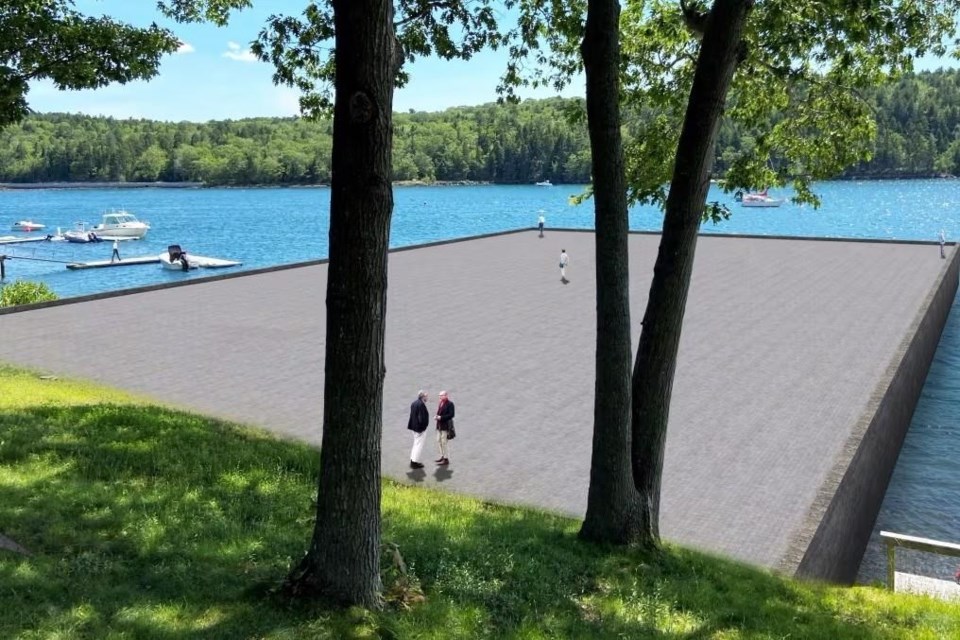Halifax's historic Northwest Arm, an inlet famous as a playground for boaters, has received protection from surrounding landowners who want to fill in the ocean with soil and rock.
Over the decades, some property owners in the area have expanded their lots along the water in the arm — just west of Halifax's main harbour — in order to add decks, gazebos and wharfs.
However, on Tuesday, Halifax city council voted to permit infilling only to reinforce walls on private properties and for public uses such as the protection of historic sites or the creation of ferry terminals.
That decision drew an enthusiastic response Wednesday from Liberal MP Andy Fillmore, who has lobbied for the change for years.
"Infilling would have meant property owners could have dumped hundreds and hundreds of truckloads of rock and soil to create land that never existed before," he said during a news conference at the St. Mary's Boat Club where dinghies have been launching since the early 1900s.
Advocates and local residents have warned that infilling of the narrow channel would cause water to rise dangerously during storm surges, potentially flooding nearby roads connecting the city's centre to its western suburbs.
There were also worries that if 155 waterfront properties keep expanding into the inlet, historic parks would be threatened and boating activities — including sailing, canoeing and rowing — would be impeded.
But the project to protect the inlet has illustrated the complexities of bringing in measures involving multiple levels of government.
The right to build on the water along Halifax harbour was part of a pre-Confederation system, created in an era when transport was often by sea, and landowners needed the right to erect wharfs for their boats.
That system left infilling applications under the purview of Transport Canada, which was primarily interested in whether the proposed decks and wharfs would impede navigation. The federal Fisheries Department also had a direct say, if its officials determined a proposal would harm fish habitats.
Following years of lobbying, Fillmore said, Transport Canada finally agreed to share jurisdiction with the Halifax Regional Municipality. A special deal worked out this year requires those seeking infilling permits to first comply with city rules.
"This is the kind of policy quagmire … that often stalls positive change. But not today," he said.
The deal between the city and the federal government was described by city staff in a recent report as unique to the Northwest Arm, as it recognizes "the historic recreational and other uses" of the area.
Patty Cuttell, a city councillor for the area, said during the news conference that while Ottawa's agreement is focused on the Northwest Arm, it sets a useful precedent for other cases of infilling around Halifax harbour.
"We need to see these waters as a usable public space," she said.
However, Coun. Sam Austin, who has been pushing for similar restrictions on the infilling of a cove in the suburb of Dartmouth, said in an interview Wednesday that it's not clear federal transport officials will agree to extend the deal to other shorelines in the city.
Austin is opposed to the dumping of pyritic slate into water lots owned by a corporation along Dartmouth Cove. He said Transport Canada should give the Halifax Regional Municipality the right to adopt a bylaw preventing this.
"These pre-Confederation water lots weren't created with the idea that people could infill them," Austin said. "They were created as a place for your wharf and to tie up your boats. They weren't created to be used in the way they're being used in a modern context."
Austin also cautioned that the Northwest Arm deal isn't necessarily permanent, as a future federal government could change its mind. "This (agreement) isn't a slam dunk. It's a nice precedent and hopefully everyone will follow it," he said.
The provincial government must still take the routine step of ratifying the municipal amendments, but Fillmore said that step is largely procedural.
"The major takeaway is this: Our Northwest Arm as we know and love it, and as generations before us have known it and loved it, is safe for Haligonians to enjoy for years to come," he said.
This report by The Canadian Press was first published Jan. 10, 2024.
Michael Tutton, The Canadian Press



